Lying Eyes and Silky Chemical Cocoons
Do your eyes give you away when you lie? In this NewsFlash, we'll explore the evidence for the idea that gaze direction can be used to spot a falsehood, as well as discover the dark, starless galaxies of the early universe. Plus, locating the cellular compasses needed for magnetic navigation and why cocooning drugs in silk can keep them active for longer, without the use of a fridge...
In this episode
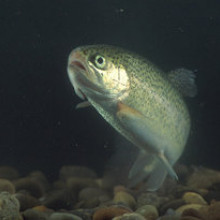
00:21 - Magnetic Field Receptor Cells Identified in the Nose of a Trout
Magnetic Field Receptor Cells Identified in the Nose of a Trout
Researchers this week have found the very cells that make up the internal compass of migratory animals. These cells are able to detect the position of the animal in relation to the Earth's magnetic field, and they do this because the cells themselves contain a magnetic component.
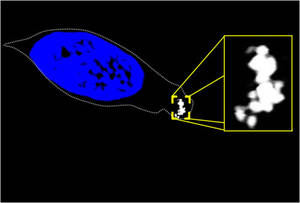 Led by Stephen Eder of Ludwig-Maximillians University in Munich, the international team took cells from the olfactory organ of a trout - that's the trout's snout - and placed them in a strong, rotating magnetic field under a microscope. Because of the way in which these cells had been prepared, they were able to move freely as the magnetic field in which they were placed rotated. When the magnetic field was applied, only the magnetic sensory cells would follow the movement of that field.
Led by Stephen Eder of Ludwig-Maximillians University in Munich, the international team took cells from the olfactory organ of a trout - that's the trout's snout - and placed them in a strong, rotating magnetic field under a microscope. Because of the way in which these cells had been prepared, they were able to move freely as the magnetic field in which they were placed rotated. When the magnetic field was applied, only the magnetic sensory cells would follow the movement of that field.
In previous years researchers have found it rather challenging to identify these cells because their exact location is quite often a subject for debate and because, in order to work effectively, these cells have to be few and far-between. When the team did identify the magnetic cells, they discovered that for every 10,000 epithelial trout snout cells, there were only about 4 of these magnetic sensory cells. And this rarity was necessary because the magneto-sensing cells had to contain a magnetic element, which itself would produce a magnetic field and could disrupt other sensory cells nearby.
The researchers believe that the cells contain the magnetic substance magnetite, which is about as magnetic as you can get in naturally occurring minerals. The next question is, given that these cells cannot rotate freely when trapped in the tissue of a living animal, how do they signal changes in the magnetic field? In the trout cells, these crystals of magnetite are locked inside the cell membrane, and the researchers hypothesise that they cause the membrane to stretch when pulled in a particular direction by the earth's magnetic field. So, at a cellular level, it may be that this membrane stretching induces a signal to the animal, telling it which way is north.
And that work is published in this week's edition of PNAS.
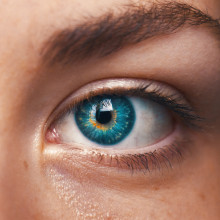
02:54 - The lies have it: lie-eye-movement link wrong
The lies have it: lie-eye-movement link wrong
The claim that people tend to look in one direction - up and to the left - when they are being honest, and a different direction - up and to the right - when they are lying, turns out not to be true...
The suggestion that gaze-direction is a dishonesty giveaway is one of the tenets of "neuro-linguistic programming" (NLP), a collection of psychological techniques that, among other things, aim to enhance an individual's communication skills.
Practitioners are taught that, when right-handed people are visualising made-up events in their mind's eye, they tend to look upwards and right. Recalling a real memory, on the other hand, is claimed to be signalled by a look to the upper left.
These claims are based on work in the 1960s by the psychologist Paul Bakan, who suggested that activity one part of the brain could sometimes spill-over into an adjacent region called the lateral eye field, which coordinates eye movements, provoking a look in one direction or the other.
But subsequent studies on this work painted a shaky picture, so University of Hertfordshire researcher Richard Wiseman and his colleagues have carried out a series of 3 "blinded" experiments to comprehensively test whether individuals really do "look shifty", or at least away from the left, when they lie.
In the first experiment, the team asked student volunteers to take a mobile phone and either conceal it about their person, or put it in a drawer and then convince an interviewer, regardless of what they'd done, that the phone was in the drawer.
As they related either the lie or truth, they were filmed. Their eye-movements were then logged, which revealed no bias in gaze direction, regardless of whether they were telling the truth or not.
In a second experiment, to determine whether training in NLP techniques somehow makes individuals more sensitive to picking up porkies, the team asked a second group of volunteers who had been previously primed about what to look out for, to review the films from the first experiment.
Although the raters who received the NLP training reported greater confidence in making judgements about lies or truth-telling, they were actually no more accurate than a group of untrained controls.
Finally, to test real-life examples of high-stakes lying, to see whether this might make a difference, the researchers analysed 52 video sequences of relatives making public pleas for the safe return of a missing relative. But in half of these cases, the person was subsequently proved to have been lying. These individuals showed no biases in their gaze directions either.
According to Wiseman and his colleagues, "These results provide considerable grounds to be skeptical of the notion that proposed patterns of eye-movements provide a reliable indicator of lying. As such, it would seem irresponsible for such practitioners to continue to encourge people to make important decisions on the basis of such claims."

07:25 - The galaxies that have no stars
The galaxies that have no stars
Astronomers using the Very Large Telescope in Chile believe they have made the first ever observations of galaxies that have no stars in them. Writing in the Monthly Notices of the RAS, Sebastiano Cantalupo's team report the discovery of 98 such galaxies, clustered around a bright quasar at a distance of 11 billion lightyears away from the Earth.
These so-called "dark galaxies" fill a gap in theoretical models of how galaxies form, as Martin Haehnelt explained when I spoke to him this week in his office at the Kavli Institute for Cosmology in Cambridge: "We have a standard model of how galaxies form, and there are predictions that we are very confident about that there should be galaxies that are much smaller than are easily visible."
The problem is that the theoretical models predict that stars form so efficiently in the early Universe that galaxies quickly run out of gas to make new stars.
By contrast, there is strong observational evidence that stars formed in the Universe over a prolonged period of 5-10 billion years after the Big Bang, and still continues now, 13.8 billion years later, albeit at a much reduced rate.
Dark, starless, galaxies solve this problem by acting as reservoirs of gas which eventually collide with larger galaxies, providing fresh new gas for later star formation.
"I wouldn't call them failed galaxies", says Haehnelt. "They're slowly developing galaxies and they're the infant stage of bigger galaxies. They will be incorporated later into more normal galaxies."
The difficulty has been working out how to detect galaxies which don't contain any stars. Astronomers usually rely on the radiation from the hot surfaces of stars to light galaxies up. Dark galaxies, by definition, aren't illuminated by any starlight.
"We were looking for another light source... to light them up like a torch", explained Haehnelt. The light source the team chose was a distant quasar, one of the most luminous known objects in the Universe.
It was also at around the right distance, 11 billion lightyears away, to probe the Universe at a time when dark galaxies were thought to be very numerous, 2-3 billion years after the Big Bang.
What the team observed in their 20-hour observation with the Very Large Telescope was the very faint fluorescence of 98 clouds of hydrogen gas, which were being excited by the intense ultraviolet light of the quasar, but which otherwise produced no detectable optical starlight.
For the first time, these dark galaxies are not just a theoretical prediction, but objects that can be observed and measured to test the ideas that cosmologists have about how galaxies have formed and evolved over cosmic history.
The 98 objects seen thus far are all in the same neighbourhood around a single quasar, but given the success of this first observing run, Haehnelt tells me that he's very hopeful of repeating the experiment around other quasars to see how other neighbourhoods compare.
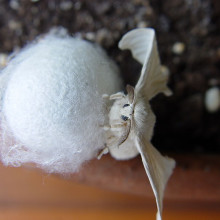
10:31 - Chemical Cocoon: Preserving Drugs in Silk
Chemical Cocoon: Preserving Drugs in Silk
David Kaplan, Tufts University
Chris - Antibiotics and vaccines save lives, but to do so, they usually need to be kept cold and this could be a bitter pill to swallow for 3rd world countries that can't afford the necessary refrigeration, despite having the most to gain from these treatments. But now, that might be about to change, thanks to a breakthrough by Tufts University scientist, David Kaplan. He's discovered that wrapping vaccines and antibiotic molecules in a layer of silk can keep them in pristine condition for months, even at temperatures above 40 degrees C...
David - My lab has studied silk for over 20 years, so we've gotten to know the protein very well. We've learned how to clean it up, how to purify it, and how to use it in medical devices, and medical materials of all kinds. As a result of that, we've also studied the ability to put things like enzymes into silk and show that they're inherently very stable under those conditions. That led us to hypothesise if an enzyme, which is a protein as well, is stable in silk, perhaps there's broader utility to entrap and stabilise other molecules like vaccines where there's a real need and a real challenge.
Chris - When we say silk, it implies a scarf or a tie or something. Are we really talking the same stuff that you would weave into a silk scarf or a silk tie when you're doing your work?
David - Yes and no. We're certainly talking about the same source material. So the material we start with comes from the textile world and that's a great thing because that means there's a huge supply of the material available which makes the cost relatively low. The downside is you would never introduce textile silk into the human body. You'd have severe problems with inflammation and you would have difficulty. And so, to use the silk, we and others have learned over the years how to get rid of all the proteins on the silk that otherwise would cause inflammation. When you do that properly, you have a very nice material that's compatible with the human body and in fact, it's been used and FDA approved in a number of medical devices already.
Chris - So, you don't get reactions with the immune system for example? It's a foreign protein so you'd think if you put that into the body that the body would recognise that as not part of it and you'd get a reaction.
David - That's right and yet, the reactions are very, very tepid and so, you don't see any kind of major problems that you'd expect. In fact, all the studies published around the world from our lab and others always show that of all the approved degradable polymers used in medical materials, silks always tend to be the lowest in terms of any inflammation or immune response. So, it has to do with the chemistry of the silk. It's a very hydrophobic molecule. It has to do with the fact that it degrades in the body very slowly and I think this combination of features helps to give this very low response.
Chris - So what did you do? You took some silk that have been prepared in the way you say and then mix them with antibiotic or even viruses to see what the silk will do.
David - That's correct. We create solutions of the silk protein in water and once you have that, we can add in essentially any bioactive molecule that you would like. In this study we showed that with vaccines and antibiotics. Then you have to process that solution into a stable material format and it can be in a form of a film, it can be in the form of a fibre, a gel or we make things like micro needles, sort of like a band aid that can administer through the skin.
Chris - When you do that, what impact does it have on the stability of the agents that you invest in silk in this way?
David - A remarkable improvement in stability, not just under refrigeration conditions, but even at temperatures as high as 45 degrees centigrade and even over 6 months, they still retain the far majority of the activity of these vaccines which is quite remarkable I think.
Chris - Compared with had you not had the silk there, the activity would by that time have just gone to zero.
David - That's correct. You would've lost all activity.
Chris - Do you know how it works?
David - In the paper, we also discuss a little bit on the mechanism and in brief, what we find is there's clearly some interactions between the silk protein itself and the proteins on - in this case - the inactivated virus that we use that appears to essentially pin the protein together and prevent it from denaturing or aggregating, and losing bioactivity. That's coupled with the low water content in the silk. And then the last point is that silk is dominated by these very, very small nanoscale hydrophobic domains. We call these beta sheets. These are the crystals. And because they're very, very small, there's lots of interfaces, lots of room for vaccines and other molecules to pin up against these structures and become immobilised and less prone to be inactivated.
Chris - It sounds like a pretty awful example for me to give to you especially when we're talking about medical things, but I've won enormous amounts of money in bars by betting people I can bend a cigarette so that one end would touch the filter end and the way you do it is by wrapping it in a 5 pound note and having the investiture of the note around the outside of a cigarette means you can make it do unfeasibly bendy things. Are the particles that you're putting into the silk, are they effectively being stabilised by this enwrapping or this sheathing in the silk, and that just stops them falling apart?
David - It's two things - one is exactly what you say. I think it prevents them falling apart or falling into the mis-shapen form so they're no longer active and the other is it prevents them from aggregating too much because there's not a lot in one spot. So I think that combination helps a lot.
Chris - How do you get the particles away from the silk again? So when you actually want to use the antibiotic or you want to metaphorically smoke the cigarette, when you want to administer the vaccine or whatever, do you need to get it away from silk or is that not necessary?
David - There are many options. There are three we most commonly talk about: One is, you can resolubilise the film with the vaccine in it and inject that and silk has been injected before. It's safe to use. There need to be more human clinical trials done, but that would be the easiest format and I think that would be very attractive. If you don't want to do that, you could certainly solubilise and then separate the vaccine from the silk. And the third, which we happen to like the best, would be when you fabricate the films, you fabricate them in these micro needle formats that I mentioned before and these become essentially a film, like a band aid strip with little pin pricks on one side so you can simply put that on your skin and the vaccine would then get through the skin based on the dissolution of the silk under the skin. So you never have to separate it from the silk. You can just use it as is, as an intact device. And so, that's very attractive because that's something you could ship around the world and then use on demand.
Chris - Isn't that amazing? You can put these things viable for months at higher than body temperature just be mixing them with some silk. That was David Kaplan from Tufts University in the US and he published that work this week in the journal PNAS.
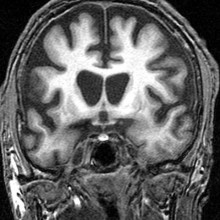
17:48 - Clearing away Huntington's
Clearing away Huntington's
Albert La Spada, UCSD; Joanna Aisenberg, Harvard University; Yosuke Marashima, University of Zurich; David Marshall, University of Leicester
Clearing Away Huntington's Disease
Two proteins have been identified to fight and potentially treat the neurodegenerative condition, Huntington's disease, according to research in the Journal Science. Patients with the condition have a gene mutation resulting in mis-folded forms of the protein Htt, which builds up in their central nervous system causing the progressive deterioration of involuntary muscle control, and cognitive decline. But now, Albert La Spada from the University of California, San Diego has found that elevating levels of the proteins PGC1-Alpha and TFEB, helps clear away mutant forms of Htt preventing their build up and resulting neurotoxic effects.
Albert - There are features of Huntington's disease that are shared by more common neurodegenerative disorders like Parkinson's diseases and so, if we can develop therapies based upon these strategies, they should not only be applicable to Huntington's disease, but also be applicable to Parkinson's disease, and perhaps other neurodegenerative disorders.
Some like it Hot
Smart materials with the ability to regulate their temperature have been developed by scientists at Harvard University, publishing in the journal Nature. Modelled on the process of homeostasis in the human body whereby body temperature is maintained at 37 degrees, these homeostatic materials consist of a surface gel layer sensitive to the temperature of its surrounding environment which in response to a drop in temperature, activates the movement of catalyst-containing structures into a second reactant layer where the catalyst initiates an exothermic reaction - causing the release of heat. When the required temperature is restored, the catalyst is removed and the reaction stops. Joanna Aisenberg led the team who hope to use the technique to control a wide range of environmental conditions.
Joanna - The prototype material shows that we can maintain a constant temperature. But in fact, the same strategy can be adapted to create materials that maintain constant glucose levels in the bloodstream or pH in water supplies. We're really thinking now of a whole range of materials that are capable of autonomous self-regulation.
How the brain encodes altruism
Altruistic Individuals have more grey matter in the region of their brain responsible for empathy. Writing in Neuron, Yosuke Morishima form the University of Zurich used fMRI techniques to monitor brain activity in human volunteers as they answered questions about splitting money between themselves and others. His team found that the volume of gray matter found a region of the brain known as the temporo-parietal junction and the level of activity there, was a strong indicator of how altruistic an individual would be.
Yosuke - When we look at other people we can't tell whether that person either denies or either generous or selfish. But our study would partly tell us about an individual's private influence which cannot be transparent. And also, some behavioural studies have shown that people who are living in really large societies tend to behave more altruistically compared to the people who live in a small societies. Maybe we might be able to elucidate the cultural influence of brain and on our behaviours.
Not Enough of a Caped Crusader
And finally, the cape used by well-known superhero batman to glide from tall buildings, would, in reality, send him crashing to the ground at high speed. Physics students at the University of Leicester calculated that the 4.7m wingspan of the cape seen in the recent films by Chistopher Nolan, which becomes rigid as an electric current passes through it, isn't big enough to enable the caped crusader to glide to safety when jumping from a building 150m high. In fact, the team led by David Marshall worked out the hero would hit the ground at 50 mph.
David M. - Batman's cape is maybe not as effective as it could be just because it's too small. When you look at it compared to a hand glider, it's about half the size that it needs to be so it keeps batman aloft. It's okay for moving, he can get to about twice as far as you can fall which is sufficient for getting between buildings, but by the time he gets there, he'll be traveling around about 50 miles an hour. So, there's a few different ways that he could fix this by getting a bigger cape, or we need some sort of active propulsion system such as jet packs. Really, Batman needs to find some better way to do with this.
The paper "Trajectory of a Falling Batman" was published in the University of Leicester Journal of Special Physics Topics.









Comments
Add a comment